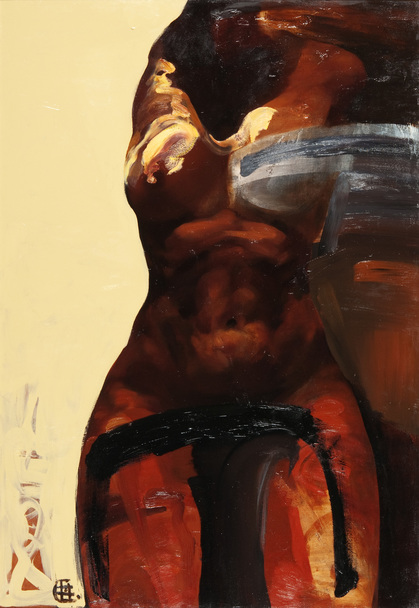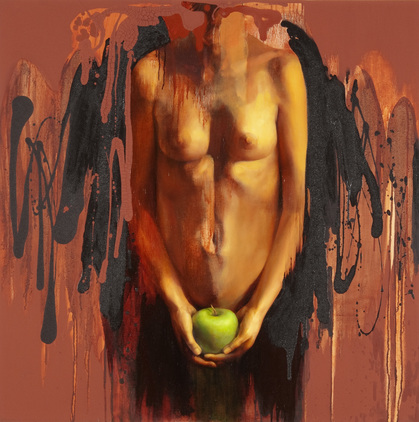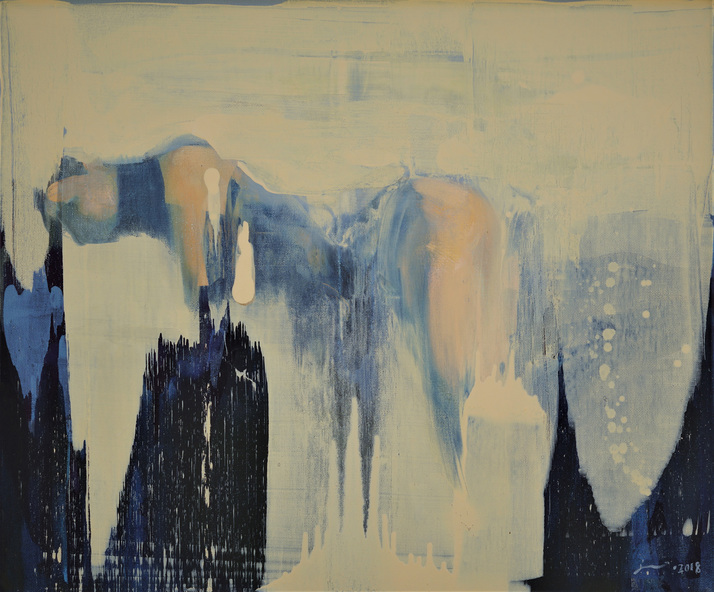
R
E
V N
E
X
T
Painter Liu Cheng Mui has spent decades exploring the boundaries between realism and imaginary composition. The Beijing native studied woodblock printing at the Central Academy of Fine Arts (CAFA), later leaving for the then Soviet Union in 1989 to pursue graduate study at the Moscow State Academy Art Institute and not returning until 1996. A year later, she relocated to Hong Kong, where she has been based since. Liu’s practice centers on an instinctive desire to delve inwards, manifesting in the vibrantly colored figurative oil canvases that she painted after a ten-year hiatus from the medium. On the occasion of Liu’s midcareer retrospective at Hong Kong’s Sun Museum, “Scenic Romance,” Lauren Long met with the artist to discuss her creative journey, the channeling of emotion through art, and the importance of close observation.
You were trained in woodblock printing; how did you develop an interest in oil painting?
When I was in Russia, I was captivated by impressionism and expressionism. The latter embodied a sense of ease, with stimulating color contrasts and exaggerated shapes. I was also drawn to the very precise, 19th-century realist paintings, like Isaac Levitan’s landscapes. To my amazement, when I went to the Russian countryside, the colors of the skies and the earth there were strikingly akin to his canvases. In 1994, I spent three months in Milan and pored over works by masters like Sandro Botticelli. The beauty of the curves he illustrated was especially enticing.
What were your academic experiences like in Beijing and Moscow?
China’s educational system used to mirror the Soviet Union’s. I found the teaching methods, styles, even modes of thought to be almost the same. What was truly inspirational was seeing Western masterpieces in person.
At CAFA, Xu Bing taught me sketching. I learned how to observe an object’s minute details, but to then break and reconstruct them, so as to not simply replicate the object. In Xu’s last class, he instructed us to draw anything from one of the hutongs. Traditional sketching requires shading and contrast to imitate three-dimensionality, but Xu wanted us to only use lines. Xu often employs elements of traditional Chinese painting, and lines are an important component of his expression. This taught me that there are many possibilities. However, when I went to Russia, I reverted to classical three-dimensional compositions.
What was it like moving back to Beijing and then to Hong Kong within a short span of time?
China’s art scene experienced a dramatic conceptual transformation between 1990 and 1996. Changes were brewing with the ’85 New Wave, but I was too young then to understand. While away I was exposed to the classics, but upon returning I confronted myriad diverse and innovative thoughts from people trying to stand out. I became lost and unsure, ceasing my creative practice. When I moved to Hong Kong, the foreign environment allowed me to embrace stillness, to think about what I wanted to do.
What motivated you to pick up your brush again after a decade?
When I finally had time for myself, I processed years of accumulation. I looked for a concrete subject to bring out my thoughts, so I had an urge to paint figures, resulting in the series of nudes [I-Phone, 2008– ]. The human body is wonderful, the beauty of its proportions and movement is unparalleled. A woman’s body is flexible; she needs to adapt as she is not strong. Her natural curvature is elegant, the possibilities for its portrayal infinite.
I paint from instinct. In [Light, 2009], the figure is tense, almost stonelike, because softness is associated with positive sensations. Meanwhile, these two [Unification and Return, both 2009] are passionate, with rapid strokes. Later, I grew calmer, and the works became an appreciation of the body. In Paradise Lost (2011), the figure is holding an apple. I am not religious, but I am interested in symbolism and the idea of rising troubles after obtaining knowledge. I paint the motifs in my mind, and only afterwards do I think about the meaning. Estrangement (2011), showing the figure’s back, is an extension of Paradise Lost. My paintings often have a front and a back, a positive and a negative. But these are all subconscious and not intentional.
Some of your later figures are more abstract, like in the Passage of Time series (2016–18). How would you describe your style?
All galleries today ask, “Do you have a style?” This has troubled me, because searching for it is cumbersome, and once you find one, you have to keep repeating what has become widely accepted. But people change. Painting for me is an agonizing process that requires inner force and motivation. Art itself is therapeutic and transformative, I do things that enable me to annihilate the past. In Passage, I cover my work with blocks of paint, a destructive act that allows me to become the observer. When you paint from life you lose yourself, but when the model leaves the room, I re-emerge via my works.
Your paintings of animals, such as your series on horses (2016–19), appear more collected.
I have become calmer with time. I may have been influenced by Spanish realism, which overemphasizes precision and technique. The Spanish realists erected structures with strings in front of models to calculate the exact measurements. This is not painting from life, but rather a dispassionate, procedural conversion. I wanted to use this to observe, to paint dogs and horses, as they are different from humans. They have life, but I do not understand them, so I can paint them purely as an observer.
Your latest Hong Kong during the Pandemic (2020) series, featuring impressionistic depictions of the city and its harbor, appears to embody an emotional approach again.
That’s why I feel like “Scenic Romance” showcases several artists. I used to avoid landscapes due to their vagueness—architectural structures are cold, skies are shapeless, and then you just have trees. But since the pandemic, I had no model, and suddenly there was a desire to paint skies. I have always been enamored of the Victoria Harbor, the way the sunrays bounce off the reflecting waters. I always thought I couldn’t do it justice. But this time I experienced the same sensations as I did when painting figures.
Installation view of LIU CHENG MUI’s “Scenic Romance,” at Sun Museum, Hong Kong, 2021. Courtesy Sun Museum.
Why the exhibition title “Scenic Romance,” which in Chinese is 「傲色」?
[The museum’s director Yeung Chun Tong] named the show. At first, I couldn’t understand it. For 色 (colors or sensuality), of course my oil works are multicolored, although there aren’t too many nudes. As for 傲 (pride), I don’t have any. I didn’t feel deserving of this title, just like how landscapes can never surpass nature’s beauty. But eventually I accepted it as an ultimate goal. Walking through the exhibition, I realized that it demonstrated the colors of my heart, which transcend reality.
What message do you want viewers to take away from your show?
A way to observe. There are many ways. Especially with contemporary art, there is no longer a need to replicate objects, so what you see is important. I was trained to see all the details, but whether or not these are depicted, and how, is up to the artist. If the audience is touched, then they must share similar sentiments; they must have seen the same shades of red or blue in their lives.
Lauren Long is ArtAsiaPacific’s news and web editor.
Liu Cheng Mui’s “Scenic Romance” is on view at Sun Museum, Hong Kong, until April 17, 2021.
To read more of ArtAsiaPacific’s articles, visit our Digital Library.

















